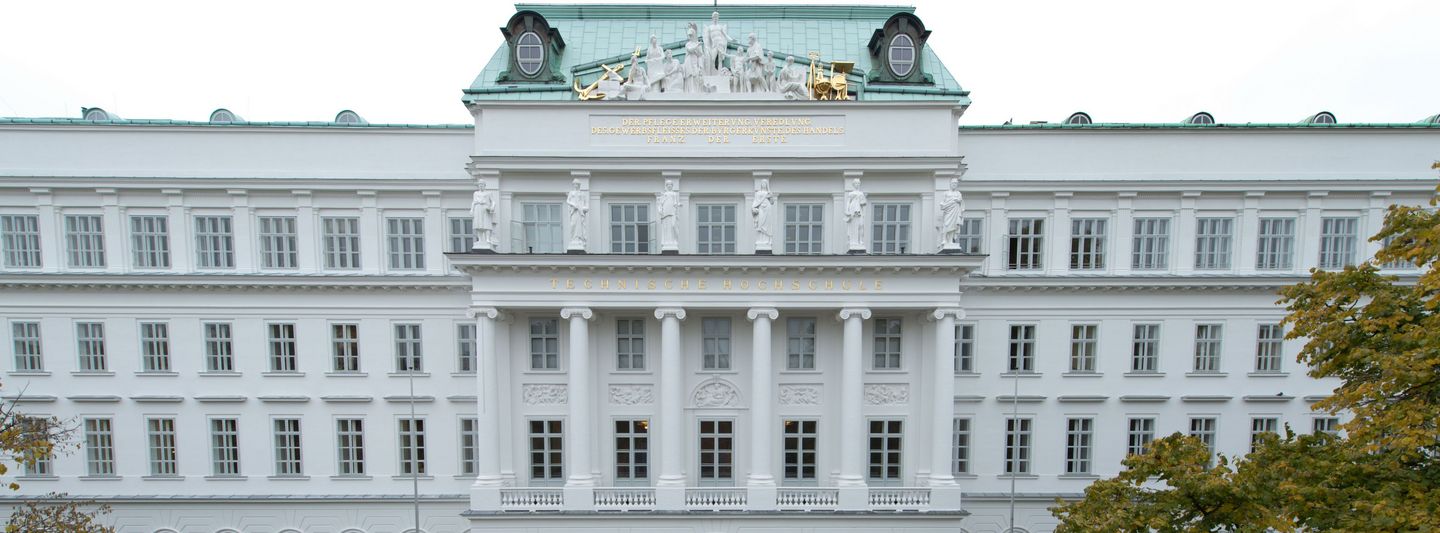Campus Karlsplatz
Report 2018
Safety Refurbishment
As part of the safety renovation of the TU main building, work on Staircase 10 was continued in 2018. The concrete work was completed by summer with the extension and connection to the fourth upper floor. After the model workshop had moved out, work began to clear the new corridor area and staircase access inside the building.
The preparatory work for the façade then began, so that the assembly of the glass elements could begin shortly before the turn of the year. At the same time, the safety refurbishment in the Ressel tract (AD) was continued. At the end of the year, this was about to be completed on the lower floors. The completion of the upper floors was delayed.
Teaching Room Center
After the closure of the basement in the tract AE (corner Paniglgasse / Karlsgasse) shortly before Christmas 2017, the necessary safety measures were initiated in the area of the new training room centre, so that the training and university operation could be continued in the tract AE again in the new year. Subsequently, extensive underpinning work was started and implemented. In summer, the staircase from the first basement floor to the ground floor was concreted and in autumn the installation of the bracing walls and false ceilings began; the technical building equipment and raw installation was continued.
Model Workshop
As a follow-up project to the BIG safety renovation, the model workshop of the Institute for Art and Design (E264) - Three-dimensional Design and Model Building moved from the attic of the Ressel tract (AD) to the ground floor of the central tract (AC), since the previous location is required as access for Staircase 10. Within one year, the historic building fabric of the former mechanical engineering laboratory was renovated and converted into a model workshop.
Kuppel 2 Inventory
In spring, the Kuppel 2 or "small Kuppel" (above the staircase 2), which is currently only used as an attic, was partly documented and measured with a drone for further usage considerations.
EB - Karlsgasse 11
At the beginning of 2018, the closure of the ceiling openings was continued and interior work started. Work began on the raw materials for the electrical and heating installations. The very extensive masonry reinforcements and structural work were largely completed in spring. Work began on the interior fittings and electrical and heating installations, and the interior fittings and media equipment were synchronised. The attic conversion was decided and will be implemented with a time delay for the general renovation.
The relocation of the Department of Spatial Planning and Spatial Planning from the alternative quarter to Karlsgasse is being prepared.
EA - Argentinierstraße - Ground Floor Zone
The demolition work on the ground floor was completed at the beginning of the year and the refurbishment and adaptation work began. Within the scope of this work, the historical return of the entrance area and the extension of the teaching and recreation areas will take place. In the second quarter, the structural work was completed and the interior work and installation work started.
The adaptation of the ground floor zone in object EA was completed on time at the beginning of the semester. In addition to the technical renewal and adaptation of the room configuration to the changed requirements by TUW, an additional entrance was also set up from Paniglgasse.
In the course of the reconstruction of the ground floor zone, a network and work room (sublet) was also set up in cooperation with "Infineon". The new "Infineon Hub" creates a meeting and interaction zone that offers space for students, teachers, researchers and experts from practice. It is available to all Infineon PhD students, Master's students and partners at TUW.
Gallery
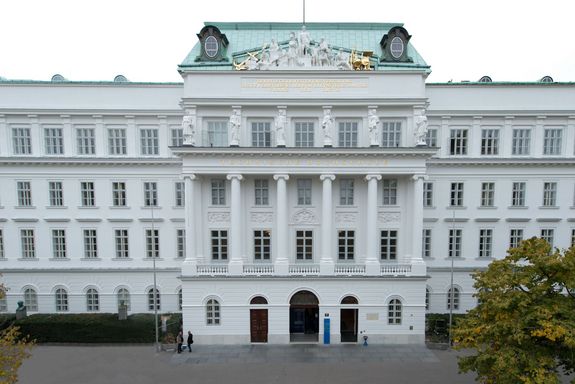
TU Main Building
© TU Wien | T. Blazina
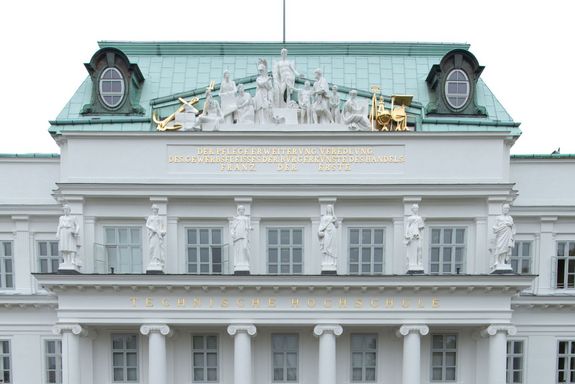
AA – Karlsplatz 13, Mittelrisalit
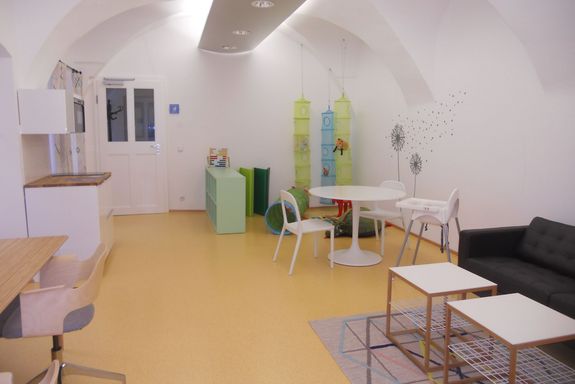
AP – Wiedner Hauptstraße 7, Parent-Baby-Area
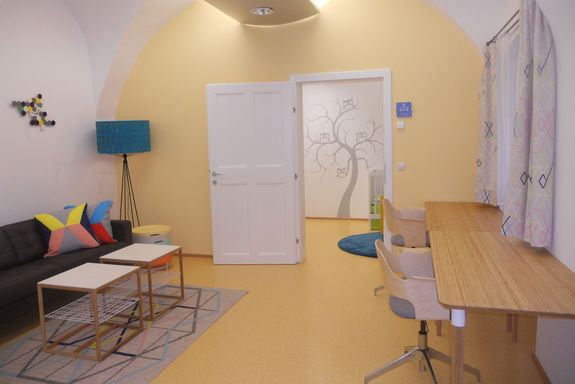
AP – Wiedner Hauptstraße 7, Parent-Baby-Area
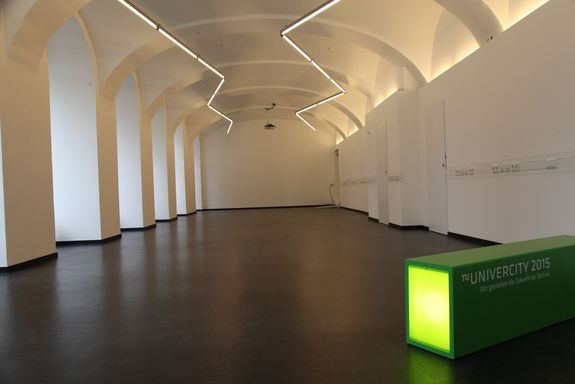
TU Corner
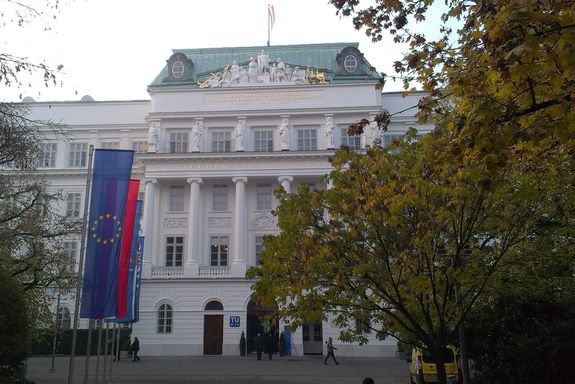
Renovated Facade of the TU Main Building
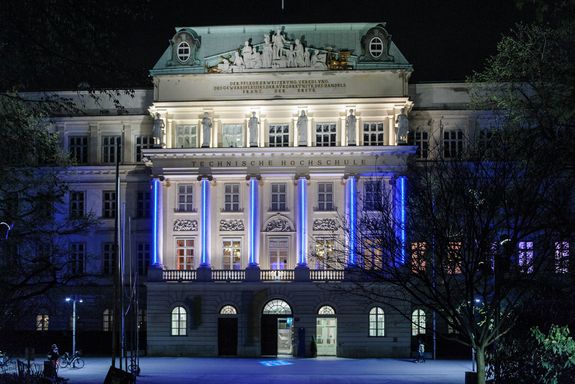
TU Main Building at night
© Raimund Appel
Previous Milestones 2006 to 2017
As the first phase of the general renovation of the main building on Karlsplatz, the restoration and rearrangement of the central risalite with the main entrance took place in 2007. The entrance area on the ground floor was designed to be user-friendly, bright and inviting. The auditorium was extended by the rooms covered with vaults on both sides. The new porter's lodge was also set up here. A spacious foyer was also opened on the first floor opposite the Festsaal, which significantly increased the attractiveness of the representative rooms Fest- und Boecklsaal for events.
The most outstanding improvement in the available space was achieved in the dome on the fourth floor. In the past, the cupola room was divided by a 2.5 m high, unexposed corridor. On one side there were several small offices and opposite the nude drawing rooms for architecture students. After the demolition of the installations from the 1950s, a cupola hall was built in the course of the general renovation in 2007 (expert opinion on the inventory assessment by Prof. DDI Wolfgang Winter, architects Nehrer + Medek and partner ZT GmbH together with architect Neumayer), which since then has made diverse uses possible (drawing hall, exhibition area, lecture hall for 240 people, event room). The almost 200-year-old wooden construction - the De L'Orms' exposed arch truss with attached mansard roof - was retained and gives the interior an unmistakable appearance.
TUW thus has an event hall measuring 25 m x 22 m, more than 10 m high in the middle. The entire renovation (Mittelrisalit including the new cupola hall) was completed at the beginning of the winter semester 2009/2010.
In the summer months of 2012, the rooms of the Institute for Water Quality, Resource Management and Waste Management on the second floor of Karlsplatz were adapted. The main orientation was the creation of a joint access and secretarial area for the two research areas Water Quality and Waste Management.
In the course of this restructuring, the professor's room was relocated, a meeting room was created and social areas for the staff were set up. Furthermore, the entire room situation was adapted to a modern office operation, all floors were renewed and the entire electrical and IT cabling was modernised.
In the course of a new appointment to the Institute of Materials Science and Technology, the laboratory rooms of the Institute at Karlsplatz were adapted.
At the beginning of 2013, the delivery and installation of the large-scale equipment for the new PVD (Physical Vapor Deposition) coating system took place. With this system, various wear-resistant coatings can be applied or evaporated onto suitable substrates using a cathode arc or a sputtering process, simultaneously supplying a reactive gas. The coating is thus the last step in tool manufacture without warping, loss of hardness or influencing the microstructure of the steel. Operation of the new Christian Doppler Laboratory commenced in the 2nd quarter of 2013.
In autumn 2015, the adaptation work for the new laboratory of the Institute for Water Quality, Resource Management and Waste Management in the AC wing was completed. On 6 November 2015, the new pilot plant named after Wilhelm Von der Emde was inaugurated in the presence of Professor Wilhelm Von der Emde.
TUW initiated a kindergarten for the TUW employees in the object Ödenburg (AQ) in Wiedner Hauptstraße 9. The old building was renovated and adapted in two stages so that five groups could be accommodated. The TU kindergarten is supervised by the association "Kinder in Wien" on behalf of TUW.
In 2013, the TU company kindergarten was extended by a further group on the ground floor of the AP building. The handover and commissioning took place on time at the beginning of the winter semester 2013/14.
On 18 December 2014, a parent-baby area was opened in Wiedner Hauptstraße 9, next to the TU kindergarten. The premises of the former TU printing house were renovated and adapted accordingly. The equipment and infrastructure suitable for small children support the compatibility of work, education and family.
TUW is the first Austrian university to offer its members this form of support in childcare.
In 2013, in Resselgasse 3, Staircase 1, areas of approx. 300 m² (approx. 100 m² office space and 200 m² cellar space) were taken over by TUW following appropriate adaptation by BIG (Bundesimmobiliengesellschaft).
In 2015/16, TUW was able to rent additional premises, so that the property is now used completely and without exception by TUW. As central units (including an office for public relations, research and transfer support, energy and environment, buildings and technology), which had previously been located at other locations, were accommodated here, the property was thoroughly renovated and adapted and rebuilt accordingly. All areas were connected, social rooms were equipped, the sanitary facilities were renewed, the heating and electrical installation were brought up to date and the surfaces were made more attractive. At the same time, the heating and escape route orientation as well as the fire alarm system were renewed by the landlord. In the summer the settlement started in stages. By the end of the year, this work could be largely completed and the new users could move in.
In the winter semester 2011/12 the premises of a former picture shop (corner Resselgasse 5 / Wiedner Hauptstraße) were taken over by the TUW. The necessary adaptation and renovation work for a multifunctional contact and service room was completed in just three months. The aging 120 m2 room is now state of the art. The adjoining area of the former caretaker's apartment now offers a kitchenette, a storeroom and a barrier-free WC.
The central location can be used, for example, for advice and information for prospective students, students or for events (panel discussions, book presentations, etc.). In addition, the rooms can be used on a case-by-case basis for activities linked to teaching events (exhibitions, presentations).
After being used as an anniversary office for the 200th anniversary celebrations, the premises of the TU Corner in Resselgasse 5 are now available to the TUW Alumni Club. In the first quarter of 2016, the furnishings and equipment were adjusted accordingly so that service operations could start in the new premises from Easter onwards.
The owner of the building, the Bundesimmobiliengesellschaft (BIG), worked out the officially required security renovation of the property. The aim of Safety refurbishment is to repair the building so that the safety requirements of the authorities for the university operation can be fulfilled.
Since the construction of the main building of TUW at Karlsplatz, various extension, conversion and refurbishment works have been carried out since then, BIG initiated a merger of all construction activities in 2003 in order to eliminate all legal and safety deficits and to obtain a corresponding user permit (notice of completion, overall consensus) for the entire building complex.
After failure of the efforts for a general reorganization individual measures were taken up and apart from general reorganization measures also the stairs 8a and the stairs 4a in the yard Resselgasse (between construction unit AC and AS) were established for the development of the necessary escape routes of the upper floors. The temporary external staircase at the main wing (courtyard 1), which was erected in the course of the renovation of the central risalit, was only to help out until the end of 2013 and had to be removed.
However, this leaves a number of important safety and fire protection measures open. For this reason, it was decided in July 2011 to initiate preliminary surveys to adapt and implement the original catalogue of measures.
It is important to take a holistic view of the house with regard to escape, fire protection and safety as well as to eliminate all deficiencies in order to obtain a permit for the use of the entire building. The adhesive plan measures do not affect user measures such as institute conversions, lecture hall renovations, etc.
The following had to be taken into account:
- All unauthorised but implemented changes over the last 30 years.
- Before this date, the alterations are considered to be a presumed consensus.
- All fire protection measures such as fire compartment boundaries, fire doors, dry or wet risers (at present the building is insufficiently divided into fire compartments). A fire alarm system must be installed for all staircases, public areas, lecture halls and corridors as well as special areas such as archives, etc.).
- Escape concept and escape routes as well as safety lighting
- Fall protection: In many areas of the building, the historical construction method has resulted in parapet areas that are too low (section of wall between floor and lower edge of window), railings and inadequate equipment in the area of building maintenance (e.g. guardrails on the roofs).
- As a replacement for the emergency staircase in courtyard 1, the construction of staircase 10 at Resseltrakt (corner AA/ AD) was situated as an extension.
TUW had then dealt with the proposed procedure for the safety renovation of the main TU building and drafted a corresponding statement. Adequate framework conditions for research and teaching must in any case be maintained.
The project was included in the economic stimulus package of the Federal Ministry of Science, Research and the Economy. Subsequently, possible construction phases were discussed, with the lamb wing crystallizing out for the first major activities inside the building. The planning for the safety-related adaptation of this wing was initiated.
In 2014, the urgently needed safety upgrade of the Karlsplatz building group was intensified by the BIG as landlord.
After the start of construction (end of 2013) with the construction of an escape route between courtyards 2 and 4, the intermediate wing AH in the area around lecture hall 7 was renovated. At the same time, the corresponding user information took place in the Faculty Councils for Architecture, Spatial Planning and Civil Engineering.
Construction work in the Lammtrakt began at the beginning of summer and was largely completed in the first quarter of 2015. Among other things, possible sample solutions for the management of electrical distribution were presented.
In autumn 2014, work began on the extensions and conversions for the lift installation next to staircase 2 in courtyard 3. In the summer of 2015, the roof level was reached. Work was completed in October. The extension now houses Staircase 2A and the new lift. In the course of the new building, the adjacent sanitary areas in Karlstrakt were also renovated.
The actual safety renovation of the BIG started in December 2016 with the construction of the new staircase 10 in courtyard 1 into the decisive phase. This was divided into three construction stages, for which it was necessary to clear the entire usable space in the main building in sections. Despite the numerous construction activities, a smooth flow of teaching and research should be guaranteed.
The former economic university in the 9th district was and is made available by the Bundesimmobiliengesellschaft as an alternative accommodation. The relocation concept of TUW ensures that individual study courses are not geographically "torn apart", so that students and lecturers have to commute as little as possible.
In the summer of 2016, the Department of Spatial Planning moved to the "old WU" for a limited time. Previously, the individual institutes were scattered across various buildings around Karlsplatz. However, the space now available offered sufficient space so that the entire department could be combined at one location for the first time. This made it possible for the individual departments and research areas to work together more directly. In this way, internal processes and working relationships could be tested and optimized, which would then create optimal working conditions in the final state. After completion of the refurbishment of the TU buildings in the Karlsgasse, the study course will return to this location in the 4th district.
In December 2016, after the legally binding contract for the general contractor services (construction) had been awarded, work began on the construction site equipment and the preparatory measures for construction phase 1 of the safety renovation. To this end, the access road and access to Hof 1 via Resselgasse were closed.
In connection with the necessary construction measures, further examinations of the building substance were carried out at the beginning of 2017 in order to be able to take the appropriate static measures.
The safety refurbishment also required appropriate coordination with the construction site with regard to the numerous events in the main TU building. In addition to the changed supply, this primarily concerned the ongoing coordination with regard to noise and dust.
The freed inner-city areas around Karlsplatz could now be used as intermediate and alternative quarters for the necessary relocations from the main building. The aim was and is to accommodate the affected institutes of the Faculties of Architecture and Spatial Planning as well as Civil Engineering largely compactly during the construction work and to prevent too great a geographical dispersion of the remaining courses of study. In the process, castling was also carried out within the various faculties, so that more institutes and departments can be bundled after completion of the security renovation.
In September 2016, these frankings of parts of Karlsplatz started. In 2017, the relocations and intermediate settlements were continued in order to enable the implementation of the security renovation.
The central facilities of the TUW were and are also involved. The organisational unit Personnel Development and Workplace Health Promotion moved from Hoftrakt (AB) to Resselgasse 5 and the department for general personnel to the first floor of Trakt AC from July.
At the same time, planning and preparatory construction measures were carried out for the relocation of the study department to the ground floor and for a classroom centre instead of the mechanical engineering laboratory, which had already moved to the arsenal.
At the turn of the year 2016/2017, the excavation pit for the new staircase 10 was excavated and secured. At the same time, the replacement access was built in the boiler room. Preparations for the demolition work were started in the inner workings of the boiler room. At the end of the first quarter, the tower crane required for feeding the individual construction areas in the Resselgasse was erected.
In the second quarter, the foundation slab was concreted and the basement walls erected. In the summer months, the staircase to the ground floor was started and the second upper floor was reached before Christmas.
In the Ressel tract, the replacement access to stairwell 4a was set up and the accompanying measures for safety renovation, in particular the modernisation of the safety installation in the main TU building, were continued.
The facade and window renovation of the Karlsplatz property will be continued by BIG in cooperation with the TUW. Until winter, the plaster, sheet metal, cornice and plinth were renovated from the middle risalit up to and including staircase 2 and renewed if necessary. In addition, the sashes and floors of the wooden box windows were extensively repaired. Now the facade shines again in new splendour.
TU Subsequent Uses
The TU subsequent use project provides for the physical consolidation of the eight faculties and their institutes at the main locations of TUW.
The concept for the future use of Karlsplatz was finalised in consultation with the deans most affected (architecture and spatial planning, civil end environmental engineering) and also presented and discussed in the faculty councils.
Furthermore, concrete considerations and representations for the accommodation of the central service facilities were mapped and the first implementation steps were started.
As an early measure of the safety renovation of the TU main building, the safety upgrade of the Prechtlsaal took place during the summer months. The emergency and escape route lighting as well as the electrical installation were renewed and brought up to the state of the art.
In the main wing, the first part of the consolidation and adaptation of the rectorate rooms was implemented. The entire rectorate will then be compactly accommodated in one line of the main wing along the Resselpark. In the next phase, the new meeting room was erected and the previous "small meeting room" was converted into a rector's office and antechamber. This work was completed by the end of the year.
As a complementary measure to the safety renovation of the TU main building by the BIG, the model workshop was moved to the AC wing (next to the room laboratory). The construction work began in spring with the demolition. At the end of the year, the cladding of the steel construction of the mezzanine stage was started. At the same time, the electrical and air-conditioning installation work was started.
On the part of the landlord (BIG), investigations on the structural condition of the object were carried out on an ongoing basis, in particular in connection with earthquake safety. TUW was informed that static retrofitting measures might be necessary for the Ressel tract (building AD).
After the clearance of the former flow laboratory in the first basement floor of wing AE (corner Paniglgasse/Karlsgasse) the excavation work for the new classroom centre was started. In addition, the foundations and load-bearing masonry were reinforced to comply with the new legal requirements (OIB guidelines).
In the course of uncovering the foundations, there was a danger to stability, which led to a fire brigade mission on the evening of 20 December 2017. Shortly after 6 p.m. the area between stairs 2 and 7 was cleared.
After the foundations had been secured by the Vienna professional fire brigade, the barriers of the adjacent streets and parts of the building could be lifted again during the night hours.
In consultation between the building authorities, the house owner BIG and the employees of the building and technology department of TUW, appropriate immediate measures were taken to secure the building section.
During the Christmas holidays the damage was repaired to such an extent that in the new year the teaching and university operation can take place again in the wing AE.
As part of the subsequent use of the TU, the first upper floor and parts of the second upper floor of the EA building were subjected to a facelift from 2015 onwards. The new Finance Department, which comprises all financial services units under the management of a CFO, was set up there.
The structure of the offices, which were previously primarily used by the Faculty of Mathematics and Geoinformation, remained largely unchanged. The social and sanitary areas were rearranged, the surfaces (walls, floors, ceilings) freshened up and the lighting and furnishings renewed.
In October, the financial services units (Controlling, Bursary, Investment Management) were able to move into their new premises exactly when the new organisational structure came into force.
Further adaptation work on parts of the fourth upper floor was completed in 2016. The surfaces (walls, floors, ceilings) underwent a facelift. The area was provisionally occupied by the SAP support of the Department of Finance.
At the beginning of 2017, the submitted adaptation of the ground floor zone was approved by the authorities. Shortly before Christmas, demolition work could begin: The ground floor zone will now be historically restored, cleaned up and will present itself from the outside as an attractive usable area in the future. The majority of the level will be converted into teaching and recreation areas.
Since the EB object has to be completely renovated in terms of safety, the Institute for Art and Design, Drawing and Visual Languages Research, has moved to Argentinierstraße 8 (EA), third floor.
After the clearing out work and the necessary technical examinations, the Bundesimmobiliengesellschaft cleared the building and after the building permit had been issued, the demolition work began.
The internal demolition work on the Karlsgasse 11 property (building component EB) was completed at the beginning of 2017. Subsequently, the masonry reinforcements were started. In the process, interesting structural details of a Viennese founder's house became visible. Thus innumerable vaults were uncovered in the lower floors and well preserved dippel tree ceilings in the upper floors. The latter are an early preform of the solid wooden ceiling: "Dippel" is derived from "Dübel" - a "wooden pin" with which the halved tree trunks were connected.
In addition, there was an interesting view: the ceilings were opened over the entire height of the house, thus allowing an unusual view of the cross-section of the house or into the open air. This "opening" was necessary to allow access to the individual floors. In autumn, the walls were reinforced to such an extent that the closing of the ceiling openings could begin.
Coordination regarding "repopulation" was discussed with the future user, the Department of Spatial Planning of the Faculty of Architecture and Spatial Planning.
The Karlsgasse 13 property will be used temporarily, especially in construction phase 1 (2017/2018), as a relocation quarter for the safety renovation of the main building. Following this intermezzo, the redesign is planned. The property is to be equipped with a barrier-free elevator system on the one hand and with an OIB-compliant staircase (OIB: Austrian Institute of Building Technology) on the other.
On the basis of the technical variant investigation initiated by TUW, the owner of the building (BIG) carried out in-depth investigations. On this basis the planning 2016/2017 was initiated. The plans for the redesign of the entrance area and barrier-free access were continued.
